Apologizing for my tardiness, I plopped myself down at our table by the window overlooking the foothill leading up to Elephant Mountain (象山). Flushed from being out in the scorching heat, I paused for a moment to catch my breath before complimenting my friend on his choice of wardrobe. It was then that we realized that our outfits — my breezy white top and flower-print skirt, and his ribbed turquoise-colored tank top and straw hat — matched the restaurant’s laidback New Orleans summer vibe.
The walls of Nola Kitchen (紐澳良小廚) are adorned with vintage record covers, while the windows peek out onto Zhongqiang Park (中強公園). The open plan of the kitchen creates a shared sense of space, giving diners a homey feel. Even the waiters and waitresses don striped shirts and straw hats to fit the nautical theme.
Nola Kitchen serves Creole food, a type of cuisine native to the southern US — notably Louisiana — that has a rich, centuries-old culinary history that encompasses influences from French, Spanish and West African styles of cooking. Using the best ingredients at hand — mostly seafood and spices — it’s known for being thick, runny and soul-satisfying. Despite a couple of criticisms in the cheese and salad department, Nola Kitchen does a good job at replicating the cuisine, down to the runniness of their stews. Either that, or I’m just a Yankee who doesn’t know how to be haughty when it comes to defending the authenticity of Southern cuisine.
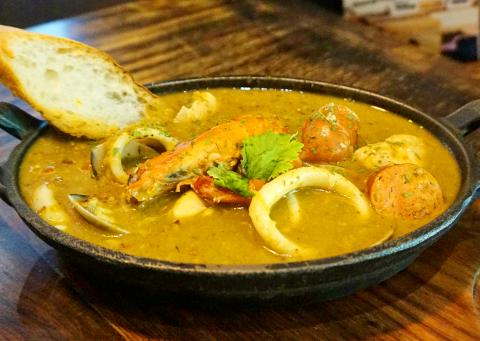
Dana Ter, Taipei Times
The mozzarella sticks (NT$180) were the biggest letdown as there was hardly any cheese. You can’t serve a classic heart attack-inducing American appetizer and neglect the most important ingredient. The epitome of the mozzarella stick is cheese that when bit into, elongates into a perfectly stringy mess. Nola Kitchen’s mozzarella sticks deprived me of this pleasure. Not only was the cheese barely discernible, but the deep-fried outer layer was too peppery and crunchy.
The seafood, chicken and sausage gumbo (NT$360) is everything a gumbo should be — the stew is neither too thick nor too watery, and the chicken, sausage, squid, clams and mussels absorbed all of its flavorful, herbal goodness. The rice, which is soaked beneath the surface of the stew, has a grainy but moist texture that pairs well with all the other components of the dish. My favorite ingredient was the sausage, which was salty and succulent. The sliver of baguette for dipping was a nice added touch. But they could have been more generous with the shrimp — there was only one. I also personally prefer my gumbos to have a spicier kick.
The chicken and waffles (NT$340) is another dish that I recommend. You can eat the chicken and waffle separately, alternating between them, or combine them as I did into a sinful sandwich. After many failed attempts at finding decent waffles — almost everything I tried was fluffy with an odd texture that makes it feel like you’re eating an air mattress — I was pleased by the softness and bready texture of Nola’s interpretation. The chicken is encased with a crisp, peppery skin and is tender on the inside. While I don’t have much of a sweet tooth, a dollop of syrup really brings out the flavors of both the chicken and waffle, making the dish feel like a combination of dessert and main all at once.
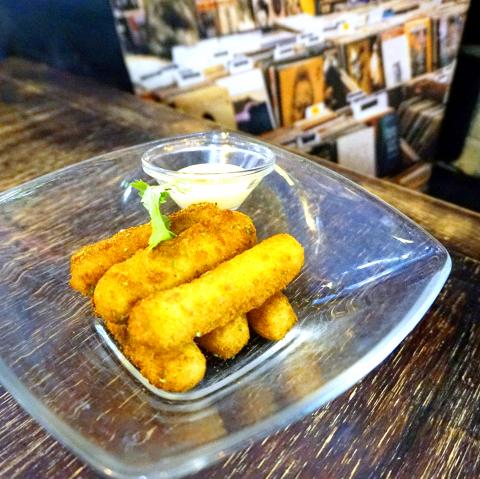
Dana Ter, Taipei Times
While the gumbo and chicken and waffles receives two thumbs up, what I don’t understand is the small helping of salad or vegetables that comes with every dish. Presentation-wise, it looks completely out of place. Cucumbers and Southern cuisine just don’t sync. Perhaps it’s a feeble attempt on the restaurant’s part to dupe customers into thinking that what they’re putting into their systems isn’t totally unhealthy. But if I’m going all out, then I’m going all out.
Cheese-less mozzarella sticks and bizarre side salads aside, Nola Kitchen is ideal for diners with big appetites looking to kick it back on a sweltering summer day.
Nola Kitchen has two other branches in Taipei, one in the ATT4Fun building by Taipei 101, 4F, 12, Songshou Rd, Taipei City (台北市松壽路12號4F), and another one by Shandao Temple (善導寺), 2, Senlin S Rd, Taipei City (台北市林森南路2號).
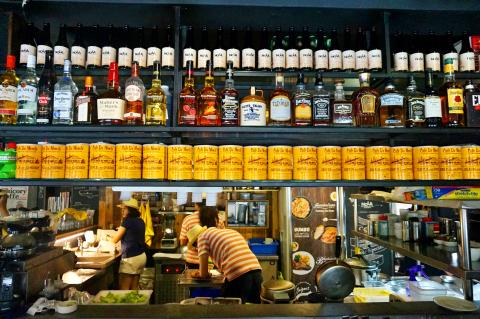
Dana Ter, Taipei Times
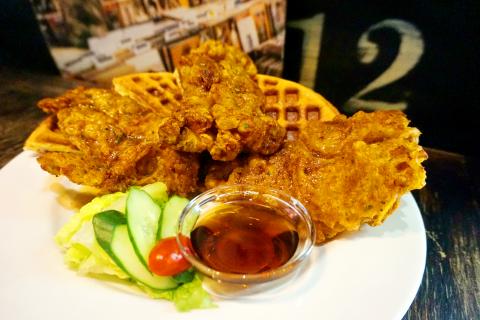
Dana Ter, Taipei Times
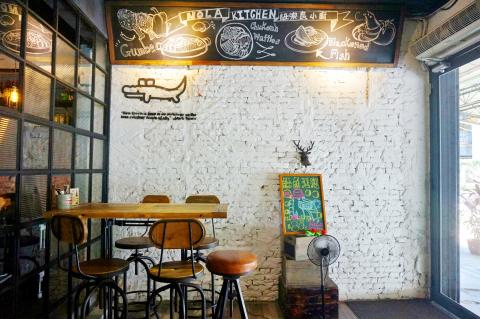
Dana Ter, Taipei Times

On April 26, The Lancet published a letter from two doctors at Taichung-based China Medical University Hospital (CMUH) warning that “Taiwan’s Health Care System is on the Brink of Collapse.” The authors said that “Years of policy inaction and mismanagement of resources have led to the National Health Insurance system operating under unsustainable conditions.” The pushback was immediate. Errors in the paper were quickly identified and publicized, to discredit the authors (the hospital apologized). CNA reported that CMUH said the letter described Taiwan in 2021 as having 62 nurses per 10,000 people, when the correct number was 78 nurses per 10,000

As Donald Trump’s executive order in March led to the shuttering of Voice of America (VOA) — the global broadcaster whose roots date back to the fight against Nazi propaganda — he quickly attracted support from figures not used to aligning themselves with any US administration. Trump had ordered the US Agency for Global Media, the federal agency that funds VOA and other groups promoting independent journalism overseas, to be “eliminated to the maximum extent consistent with applicable law.” The decision suddenly halted programming in 49 languages to more than 425 million people. In Moscow, Margarita Simonyan, the hardline editor-in-chief of the

Six weeks before I embarked on a research mission in Kyoto, I was sitting alone at a bar counter in Melbourne. Next to me, a woman was bragging loudly to a friend: She, too, was heading to Kyoto, I quickly discerned. Except her trip was in four months. And she’d just pulled an all-nighter booking restaurant reservations. As I snooped on the conversation, I broke out in a sweat, panicking because I’d yet to secure a single table. Then I remembered: Eating well in Japan is absolutely not something to lose sleep over. It’s true that the best-known institutions book up faster

Though the total area of Penghu isn’t that large, exploring all of it — including its numerous outlying islands — could easily take a couple of weeks. The most remote township accessible by road from Magong City (馬公市) is Siyu (西嶼鄉), and this place alone deserves at least two days to fully appreciate. Whether it’s beaches, architecture, museums, snacks, sunrises or sunsets that attract you, Siyu has something for everyone. Though only 5km from Magong by sea, no ferry service currently exists and it must be reached by a long circuitous route around the main island of Penghu, with the